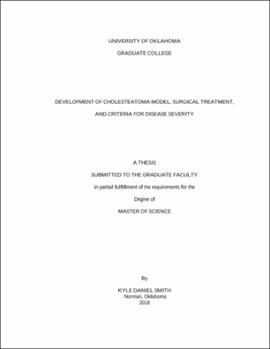| dc.description.abstract | Chapter 1:
Cholesteatoma is a middle ear disease characterized by a cystic lesion that grows from the tympanic membrane. There are several theories as to the cause of the disease, though the most prominent cause is eustachian tube dysfunction. Using an animal model to characterize the disease and develop a method for surgical eradication is a novel research area as most often animal models are used to describe the disease and the damage caused to the middle ear by the disease. Medical intervention is solely surgical, so an animal model to explore intervention and reconstruction techniques would be a valuable resource, which is the focus of this study.
Chapter 2:
A cholesteatoma anima was developed in chinchillas by injecting propylene glycol through the tympanic membrane and into the middle ear cavity, at concentrations of 70 and 90%. The disease developed for 2-6 weeks to achieve different levels of severity. Hearing function tests were used to compare hearing levels before and after inoculation. At the end of the inoculation time course, the cholesteatoma was eradicated surgically. Animals that survived surgery recovered for two weeks, and final hearing levels were measured. One animals that survived surgery was imaged with micro-CT. Also, three animals were euthanized early in the study at one, two, and four weeks for three different cholesteatoma levels.
Chapter 3:
In this pilot study, a primary outcome is the method for building the disease model in chinchillas. Also, a method for surgical intervention and reconstruction has been developed for chinchillas. Hearing measurements including wideband tympanometry and auditory brainstem response were taken before inoculation, after the disease time course, and after surgical intervention, though only one animal had measurable results for each measurement point; some hearing recovery after reconstruction was measured. Histology images show the results of different inoculation time frames, providing a basis for a classification of this animal model’s disease states. Finally, micro-CT images taken after recovery show the damage in the middle ear due to cholesteatoma.
Chapter 4:
Based on endoscopic photographs, histology sections, and micro-CT scans, a characterization of cholesteatoma growth has been developed with three levels of severity: mild, moderate, and severe. Hearing function recovery in chinchillas has been demonstrated, though significant improvement in surgical reconstruction is required for future studies.
Chapter 5:
Preliminary results suggest a that these methods will results in cholesteatoma models at different levels by controlling time, propylene glycol concentration, and inoculation volume, though the greatest factor is time. This should be later verified with larger studies for statistical analysis. Cholesteatomas can be surgically removed from chinchillas and hearing function can be regained after reconstruction. Future studies should include disease specific prosthesis to enhance hear recovery. | en_US |
